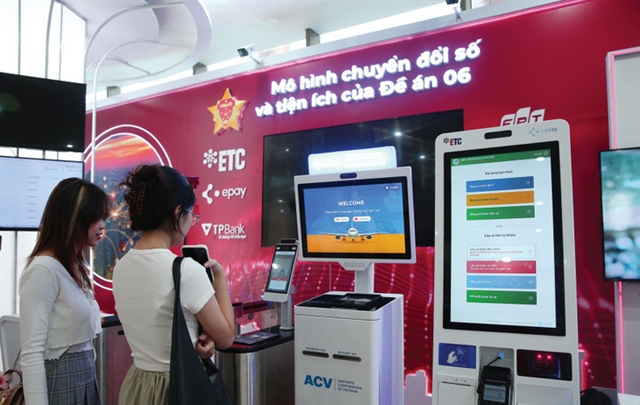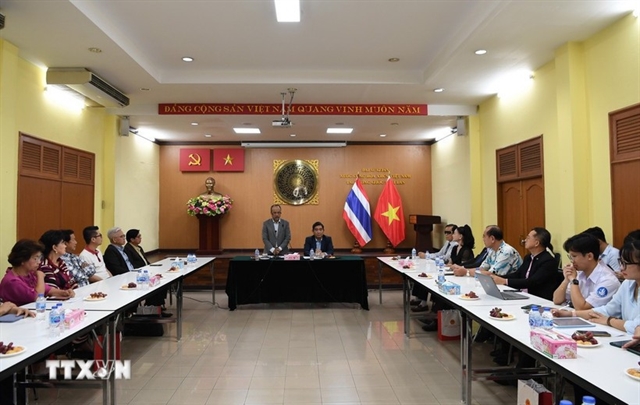 Business Beat
Business Beat

Economists said the State-owned sector’s tardy growth reveal an imbalance between business results (revenue) and investment including assets and capital used for production.
| ||
| A view of the Ninh Bình Nitrogenous Fertiliser Plant, managed by the Việt Nam Chemicals Corporation (Vinachem). — Photo zing.vn |
At the Việt Nam Industrial Construction Corporation (Vinaincon)’s annual general meeting this year a report from its supervisory board said the company achieved only 77.5 per cent of its revenue target in 2018.
It reported sales of VNĐ3.25 trillion (US$139.5 million) and after-tax loss of VNĐ284 billion ($12.2 million).
Its subsidiary, Quang Sơn Cement company, made a loss of VNĐ361 billion ($15.5 million).
This year Vinaincon, a State-owned company, estimates it is likely to make a loss of VNĐ95 billion since Quang Sơn, the biggest contributor to its revenues, is forecast to remain in the red.
The Ninh Bình Nitrogenous Fertiliser Plant, managed by the Việt Nam Chemicals Corporation (Vinachem) is in a similar situation.
It is struggling to maintain production and reduce losses.
According to the latest report from the Ministry of Industry and Trade, which owns the company, the plant has made a loss of VNĐ135.8 billion so far this year.
Vinachem chairman Nguyễn Phú Cường said the Ninh Bình plant is likely to go bankrupt at any time since it did not have enough working capital to maintain production. Banks are wary of lending to it.
Economists said the State-owned sector’s tardy growth reveal an imbalance between business results (revenue) and investment including assets and capital used for production.
Its growth still mainly depends on capital, land and labour, and State-owned enterprises (SOEs) do not create added value commensurate with the resources they use, they said.
The worst offenders in this case are SOEs involved in the exploitation of natural resources and infrastructure development.
Most of the companies making profits are involved in less competitive industries such as natural resource exploitation or those in which they have a monopoly, such as telecommunications and energy.
To improve the efficiency of the public sector, experts said it is necessary for the Government to carefully consider providing it with resources including capital, assets and human resources and strengthen oversight and auditing of the capital and assets allocated to it.
They also stressed the need to soon have metrics to precisely measure the efficiency of SOEs and their managers.
Keeping State ownership at a proper level to attract investors from outside and changing their management models are imperative to improve the enterprises’efficiency, they said.
Basel II and strategic stakes
Some banks expect to find it easier to raise capital since they have met Basel II’s capital safety and risk management standards.
With this expectation, many have drafted plans to sell stakes to foreign investors as soon as they get the green light from the State Bank of Việt Nam to adopt the recommendations on banking laws and regulations issued by the Basel Committee on Banking Supervision.
In June the Maritime Commercial Joint Stock Bank received approval. It immediately outlined a plan to sell 20 per cent to international investors, including all its treasury stocks, which account for 10 per cent of its stakes.
The lender’s general director, Huỳnh Bửu Quang, said it has done road shows in Thailand and Singapore to promote its brand and capital raising plans and plans to do another in Hong Kong involving major global financial institutions.
In May the Military Joint Stock Commercial Bank also received permission to adopt Basel II.
Its general director, Lưu Trung Thái, said the bank would sell 258.4 million new shares and 47 million treasury stocks to both local and foreign investors.
Analysts said compliance with Basel II norms would mean a bank is recognised as safe, efficient and transparent, and would be operating under stricter rules for risk management based on international standards, helping enhance its position and improve competitiveness.
For most lenders, increasing capital is key to achieving their growth targets and improving their competitiveness not only vis-a-vis domestic rivals but also foreign, many of whom are planning to enter the Vietnamese market.
In recent years not all the lenders have succeeded in raising capital due to various reasons, and so expect Basel II compliance to make them more attractive to investors.
But many experts are sceptical, saying just meeting the Basel norms is not enough for them.
They suggested that banks should speed up identification of potential foreign strategic investors because the latter are not going to wait forever for them.
Senior economist Dr Cấn Văn Lực said mobilising capital from foreign investors is the easiest way for lenders to improve their finances since there are too few domestic players with deep pockets.
EU trade deal boost
A day after the EU-Vietnam Free Trade Agreement (EVFTA) was signed on June 30 the share prices of many Vietnamese garment and textile enterprises rose sharply.
But market observers said the shares of textile companies had begun to rise in the early part of the year, well before the signing of the deal.
GMC shares were traded at the price of around VNĐ25,000 per share in 2018 but raised to VNĐ42,200 in May 20, registering an increase of 19.38 per cent compared to early 2019. According to an unaudited report, GMC gained VNĐ135 billion in 2018, doubling the figure in 2017.
Exports of textile and garment and footwear to Europe were worth around $9 billion last year when the average tariff was around 9 per cent.
The trade deal will remove 99 per cent of tariffs between the two sides, with 65 per cent eliminated immediately. The remaining tariffs will be phased out in 10 years.
Additionally, the strong commitment to an open, fair and rules-based trade would further expand export markets for Việt Nam, especially in textile, garment, agriculture, fisheries, and wood furniture, Phạm Hồng Hải, CEO of HSBC Vietnam, said.
Analysts said textile and garment enterprises that have a closed production chain (yarn, fabrics and garment) would benefit the most from the deal since they would find it easier to meet EU countries’ stipulations related to origin.
But those involved in outsourcing would not benefit much, they said.
The Sài Gòn Garment Trading Manufacturing Joint Stock Company expects to expand exports to the EU this year.
Many of its customers there have increased their orders by 20-30 per cent for this year and the next few, a company spokesman said.
A TNG Investment and Trading Joint Stock Company executive expected the EVFTA to have positive effects on his company’s business as export tariffs are cut to zero in the next three years.
The trade deal would improve the competitiveness of Việt Nam’s textile and garment industry against other countries like Bangladesh, Cambodia, Myanmar, and China, he said.
To grasp the opportunity, TNG has expanded production capacity by 10 per cent.
Experts from BIDV Securities Joint Stock Company said EVFTA would benefit most textile and apparel companies whose exports to the EU account for a majority of their exports.
Among them are TNG, 50 per cent of whose exports go to EU countries, GMC (41 per cent) and Sông Hồng Garment (30 per cent). VNS




